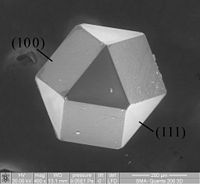
Photo from wikipedia
Nanostructured materials represent an interesting and novel class of support matrices for the immobilization of different enzymes. Owing to the high surface area, robust mechanical stability, outstanding optical, thermal, and… Click to show full abstract
Nanostructured materials represent an interesting and novel class of support matrices for the immobilization of different enzymes. Owing to the high surface area, robust mechanical stability, outstanding optical, thermal, and electrical properties, nanomaterials have been rightly perceived as desired immobilization matrices for lipases immobilization with a wide array of biotechnological applications such as dairy, food technology, fine chemical, pharmaceutical, detergent, and oleochemical industries. Lipases immobilized on nanomaterials have demonstrated superior attributes than free counterparts, such as aggrandized pH and thermal stability, robustness, long-term stability, and the possibility of reuse and recycling in several times. Here we review current and state-of-the-art literature on the use of nanomaterials as novel platforms for the immobilization of lipase enzymes. The physicochemical properties and exploitation of a large number of new nanostructured materials such as carbon nanotubes, nano-silica, graphene/graphene oxide, metal nanoparticles, magnetic nanostructures, metal-organic frameworks, and hybrid nanoflowers as a host matrix to constitute robust lipases-based nanobiocatalytic systems are discussed. Conclusive remarks, trends, and future recommendations for nanomaterial immobilized enzymes are also given.
Journal Title: International journal of biological macromolecules
Year Published: 2020
Link to full text (if available)
Share on Social Media: Sign Up to like & get
recommendations!